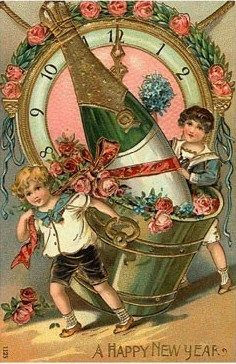 QUESTION: I collect greeting cards. And recently while searching for some old Christmas cards I could purchase for my collection, I discovered some New Year’s greeting cards. I never knew that people sent cards at New Years. What can you tell me about this tradition?
QUESTION: I collect greeting cards. And recently while searching for some old Christmas cards I could purchase for my collection, I discovered some New Year’s greeting cards. I never knew that people sent cards at New Years. What can you tell me about this tradition?
ANSWER: People in the 19th and early 20th centuries sent greeting cards for a number of holidays, including Thanksgiving, Easter, Christmas, and yes, New Years. That was before modern communications made it easier to pick up the phone—or today a cell phone—and speak directly with the another person. Also, mailing greeting cards was inexpensive since the U.S. Post Office hadn’t begun its wild ride of price increases. And today, it’s also possible to send a digital greeting card through the Internet. But let’s take a look back at how the practice of celebrating the New Year began.
New Year's Day, also simply called New Year's, is observed on January 1, the first day of the year on the modern Gregorian calendar as well as the Julian calendar. But it wasn’t always on that day.
In pre-Christian Rome under the Julian calendar, the day was dedicated to Janus, god of gateways and beginnings, for whom January is also named. As a date in the Gregorian calendar of Christendom, New Year's Day liturgically marked the Feast of the Naming and Circumcision of Jesus, which is still observed as such in the Anglican Church and Lutheran Church. The Roman Catholic Church celebrates on this day the Solemnity of Mary, Mother of God.
 The practice of celebrating the New Year whenever that occurred dates back to 2,000 B.C.E. in Mesopotamia, when people celebrated it in mid-March around the time of the vernal equinox.
The practice of celebrating the New Year whenever that occurred dates back to 2,000 B.C.E. in Mesopotamia, when people celebrated it in mid-March around the time of the vernal equinox.
The early Roman calendar designated March 1 as the first day of the year. The calendar had just 10 months, beginning with March. That the new year once began with the month of March is still reflected in some of the names of the months. September through to December, the ninth through to the twelfth months of the Gregorian calendar, were originally positioned as the seventh through to the tenth months. Septem is Latin for "seven"; octo, "eight"; novem, "nine"; and decem, "ten.” Roman legend usually credited the second king Numa with the establishment of the two new months of Januarius and Februarius. These were first placed at the end of the year, but at some point came to be considered the first two months instead.
But in 567 C.E., the Council of Tours formally abolished January 1 as the beginning of the year. At various times and in various places throughout medieval Christian Europe, the new year was celebrated on December 25 in honor of the birth of Jesus, March 1 in the old Roman style, March25 in honor of Lady Day and the Feast of the Annunciation, and on the movable feast of Easter. No wonder the world seemed confused.
 It was the custom among 7th-century pagans of Flanders and the Netherlands to exchange gifts on the first day of the new year. But as it turned out, European Christians also celebrated the new years on that date because New Year's Day fell within the 12 days of the Christmas season in the Western Christian liturgical calendar.
It was the custom among 7th-century pagans of Flanders and the Netherlands to exchange gifts on the first day of the new year. But as it turned out, European Christians also celebrated the new years on that date because New Year's Day fell within the 12 days of the Christmas season in the Western Christian liturgical calendar.
However, it was the Japanese who originated the custom of sending written New Year’s greetings during the Heian Era, lasting from 794 to 1185 C.E. During that time, the nobility started to write such letters to people who lived too far away for the usual face-to-face New Year greetings.
Though the use of the Gregorian Calendar dates from 1582, when Pope Gregory XIII declared it to be used, it wasn’t until 1752 that Britain adopted it.
The practice of sending New Year’s greeting cards probably didn’t begin in the United States until the 1870s. It took several decades before the practice of sending Christmas cards had caught on, and soon sending greetings for other holidays followed.
The first cards were simple postcards, with a greeting printed on one side and a place for the receiver’s address on the other. But it wasn’t until 1915 that folded greeting cards, first created by Hallmark, began to appear.
To read more articles on antiques, please visit the Antiques Articles section of my Web site. And to stay up to the minute on antiques and collectibles, please join the over 30,000 readers by following my free online magazine, #TheAntiquesAlmanac. Learn more about "Celebrating an Olde Fashioned Holiday" in the 2020 Holiday Edition, online now. And to read daily posts about unique objects from the past and their histories, like the #Antiques and More Collection on Facebook.















































